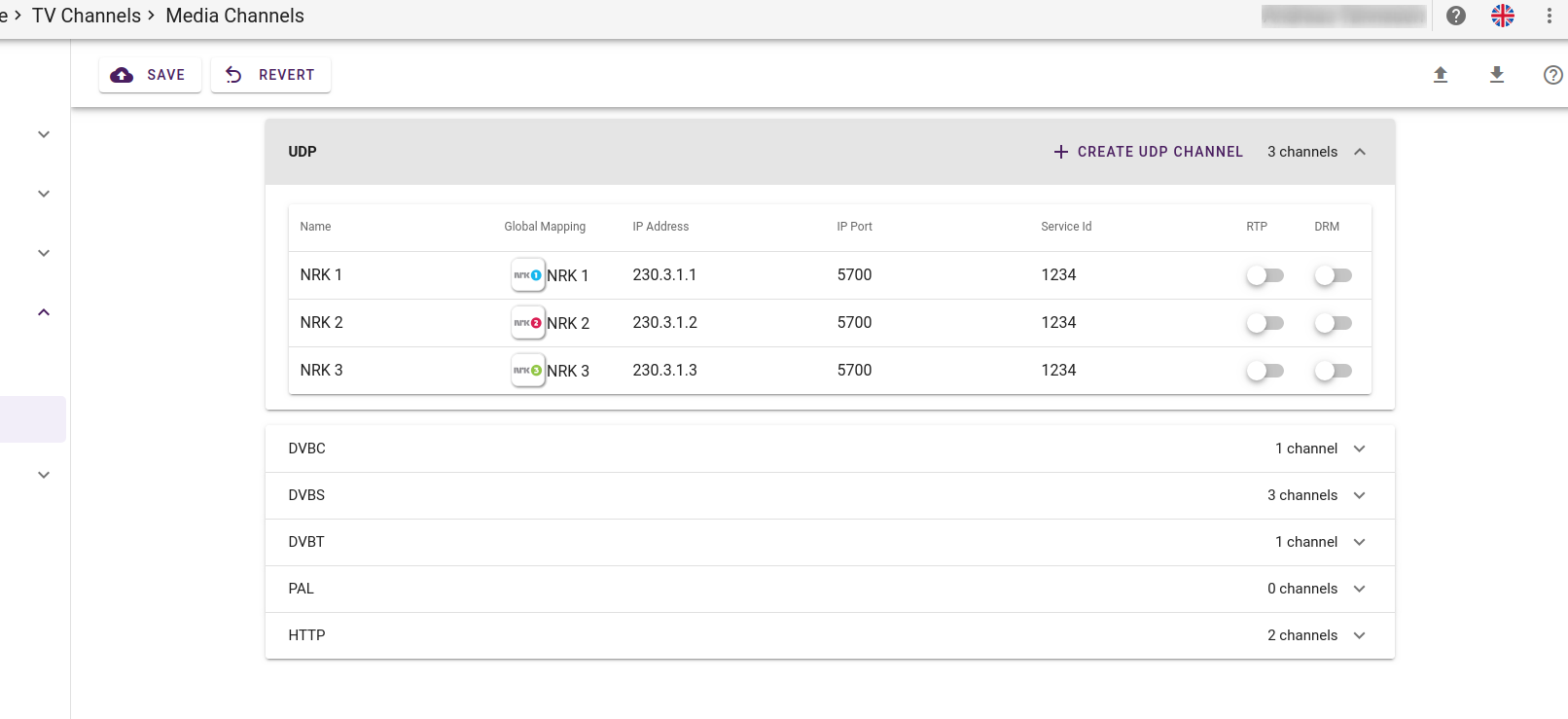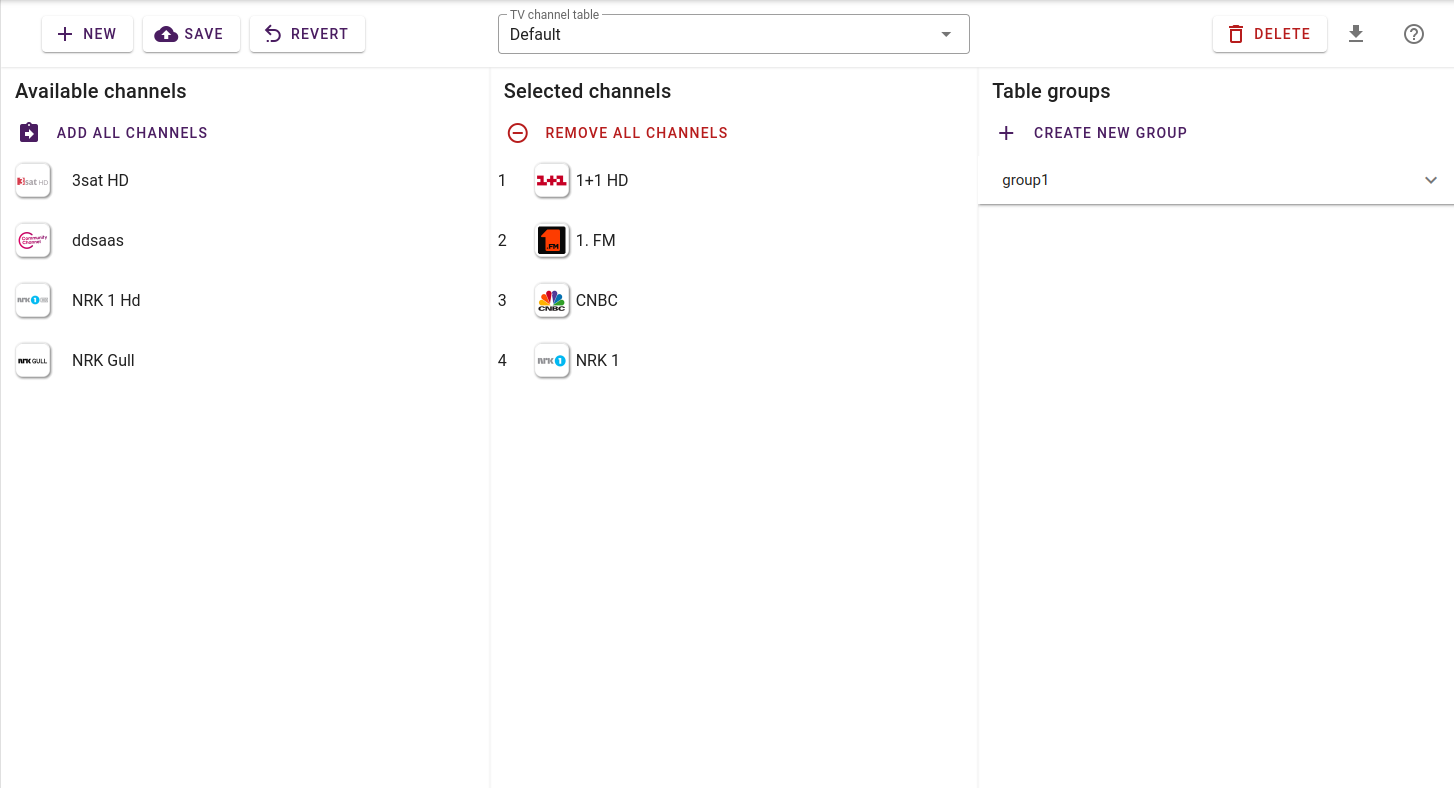To provide a traditional linear TV-experience Media Channels are grouped together to form Channel Tables. These Channel Tables are then set as part of the screen configurations.
Media Channels are separated from the Channel Tables to provide separation of the definition of the channel content source and settings (IPTV, DVB-C etc) and the more high-level management of the channel table layouts.
¶ Media Channels
The Media Channel editor is available in the site context under TV Channels -> Media Channels:

¶ Common Concepts
¶ Global Channels and mapping
To be able to automatically download channel icons and, in the future, gather statistical data across sites, channels must be mapped to the global channel list. After creating a new channel, click in the mapping field to bring up the search window with an attempted auto-search.
¶ Other common concepts
Some common concepts across most of the transmission layers are:
-
Service ID - The service ID is a concept from the broadcasting world. A service ID identifies a service in a multiplexed stream so that even if the multiplex carries many services, the receiver is able to play back one service. In this case a service can be translated to a "TV Channel".
-
DRM - Digital Rights Management. Copy/playback protection can be applied to a media stream. For the LG screens the Pro:Idiom DRM scheme can be used, while for Samsung Tizen and Orsay the LYNK CAS type 1 and 2 are available for IPTV as well as Pro:Centric for US models. For screens that require DRM configurations set, the data is set under screen configurations per vendor type.
NOTE
For now there is no DRM support for Philips models. For Samsung Tizen, DRM is only available for IPTV channels.
NOTE
Frequencies are to be set in Kilohertz. This usually means a 6-digit number eg 419000.
¶ UDP
The UDP channel type is the common IPTV transport for linear content over CAT networks. The most common way is to multicast raw MPEG-TS/DVB streams on an UDP port. Another common option is to use RTP for package ordering.
Samsung Orsay screens need explicit instruction if an IP-stream only contains audio, therefore there is an audioOnly option for IP-channels.
-
IP - the IP multicast address to join to receive the signal.
-
Port - the UDP port to listen on.
¶ DVB-C
The DVB-C transmission type is what's commonly known as cable TV in many countries. TV-signals are modulated and transmitted in multiplexes over a copper medium. The ServiceID is therefore essential when defining DVB-C channels.
-
Frequency - The mux is transmitted on this frequency. In KiloHertz.
-
Modulation - The modulation type used. QAM-64, QAM-128 or QAM-256.
-
Symbol Rate - The symbol rate used. In KiloHertz.
-
ServiceID - The service Id of the TV-channel.
Example:

¶ DVB-T
DVB-T is used for terrestrial transmission of digital TV-channels. It is in many ways similar to DVB-C but has fewer configurable parameters. The signal can also be carried on copper cables.
-
Frequency - The mux is transmitted on this frequency, in KiloHertz.
-
Bandwidth - The channel bandwidth. 7 or 8 MHz
-
ServiceID - The service Id of the TV-channel.
-
T2 - This controls the modulation type used. OFDM for DVB-T2 and 8PSK for DVB-T
Example:

¶ DVB-S
Using DVB-S is not recommended as it has proven difficult to configure with various hospitality models.
-
Frequency - The mux is transmittet on this frequency. In KiloHertz.
-
SatelliteID - The satellite ID from the transmitting satellite.
-
ServiceID - The service Id of the TV-channel.
-
Polarization - The signal orientation: Horizontal, Vertical, Left H Circular or Right H Circular.
-
Program number - The unique index within the multiplex (the combined stream of multiple channels) for the specific channel
-
Symbol Rate - The symbol rate used in kHz.
-
S2 - This controls the modulation type used.
-
PTC - The specific physical channel (or transponder) on a satellite that carries a set of TV and/or radio services.
Program Number and PTC parameters are only necessary for Samsung Orsay TV screens.
For a list of Satelite IDs used in the Samsung TV-sets click here.
¶ QAM (J.83. Annex B)
QAM (J.82.B) is the common way of transmitting digital TV-channels over coax networks in the USA. This is supported on US models.
-
PTC - The specific physical channel (or transponder) on a satellite that carries a set of TV and/or radio services.
-
Program number - The unique index within the multiplex (the combined stream of multiple channels) for the specific channel
¶ ATSC
ATSC is the common way of transmitting digital terrestrial TV-channels networks in USA. This is supported on US models.
-
Major Number - The major number for ATSC represents the original analog or non-simulcast channel frequency.
-
Minor Number - The minor number is a sequentially assigned number for the selected channel with zero reserved for the analog channel.
¶ PAL
PAL is an old analogue standard used in many European countries. It is still supported on many hospitality screens. PAL carries one channel per frequency.
- Frequency - channel frequency. In KiloHertz.
¶ HTTP
HTTP playback loads and plays back video from URLs. This is an on-demand way of transmitting the media, and therefore it does not support multicasting. To optimize network load the HTTP source should be located as close to the receiver as possible. In a hotel, 100 TVs streaming from an Internet service will consume 100 X the stream bandwidth. However, if you could use an on-premises proxy you might only use 1 X the stream rate.
-
Type - We separate between the HLS streaming standard and Progressive HTTP playback. HLS was introduced by Apple, and has since become somewhat of a standard in the on-demand streaming world. However it requires various components server-side to serve the data. Progressive HTTP playback on the other hand, just requires a HTTP server serving the video file.
-
Audio Only - Samsung Orsay models require prior knowledge of streams that are Audio Only to operate properly. IF the stream does not carry video, please set this option (especially if you are using Orsay screens).
-
Web Radio Search - You can search in our central web radio channel directory to be included in the channel list. Start typing and the result list will be populated. When you select a web radio channel, name, type, url and audio only will be automatically populated.
¶ Exporting and Importing
The Media Channel editor supports exporting the current media-channels to a CSV file and importing a file of the same format.
The file needs to follow the exact format for the export using the columns:
name,type,globalId,serviceId,ipAddress,ipPort,frequency,modulation,symbolRate,satteliteId,polarization,bandwidth,rtp,t2,s2,url,audioOnly,drm
Where each media-channel is represented by a line of comma-separated values.
NOTE
All media channels imported from CSV are appended to the list. There is no concept of exporting the identificator of a channel, so an import will never overwrite or replace any current entries in the media channel list.
Global mapping is maintained.
¶ Channel Tables
The Channel Table editor is available in the site context under TV Channels -> Channel Tables:
![channel_tables.png]
You can define as many channel tables as you'd like and use these in different configuration sets. A channel table consists of an ordered list of channels. Drag and drop channels from the left-hand column into your table and also use drag and drop to arrange the channel order.
You can create Channel Groups within a channel table. These groups are used to filter the channel-table in the TV-GUI for easier access to different types of channels.